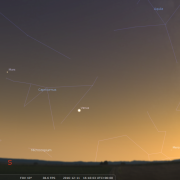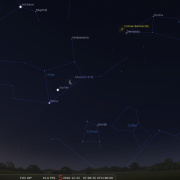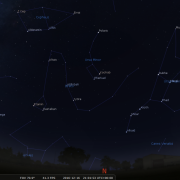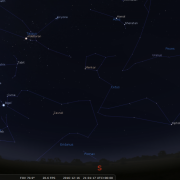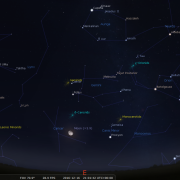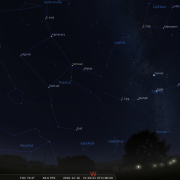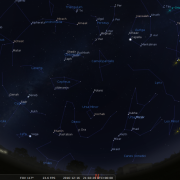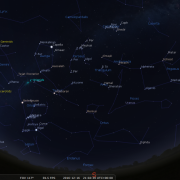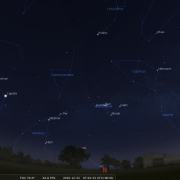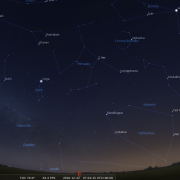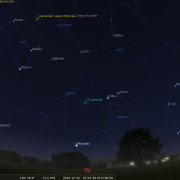In this month's Sky Notes:
Planetary Skylights
 Here’s a planetary observing challenge, during the first half of the month elusive Mercury makes a half hearted appearance in the evening twilight, very low in the SW sky. The optimum dates to spot Mercury are from the 9th to the 19th, shortly after 16:00h, but you will require an unobstructed horizon as mercury will be no more than 3 or 4 degrees above it at best - if you observe just over half an hour after sunset. On the 11th Mercury reaches greatest eastern elongation, approximately 18 degrees or just over a hands span (arm’s length) to the left of the Sun, but still just a few degrees above the horizon. Once tracked down (using binoculars if required) you should be able to pick it out of the twilight with just the naked eye, but you will have to be sharp. Good hunting.
Here’s a planetary observing challenge, during the first half of the month elusive Mercury makes a half hearted appearance in the evening twilight, very low in the SW sky. The optimum dates to spot Mercury are from the 9th to the 19th, shortly after 16:00h, but you will require an unobstructed horizon as mercury will be no more than 3 or 4 degrees above it at best - if you observe just over half an hour after sunset. On the 11th Mercury reaches greatest eastern elongation, approximately 18 degrees or just over a hands span (arm’s length) to the left of the Sun, but still just a few degrees above the horizon. Once tracked down (using binoculars if required) you should be able to pick it out of the twilight with just the naked eye, but you will have to be sharp. Good hunting.
 Venus on the other hand should be much easier to spot, a brilliant beacon low above the SW horizon. As we head through December, Venus gains a little in altitude, and therefore prominence, masquerading as the ‘Christmas star’ over the festive period. Telescopically Venus exhibits a distinct half phase, although no other detail is visible due to the constant duvet of obscuring cloud. View on the 3rd when a slim crescent moon lies directly above Venus.
Venus on the other hand should be much easier to spot, a brilliant beacon low above the SW horizon. As we head through December, Venus gains a little in altitude, and therefore prominence, masquerading as the ‘Christmas star’ over the festive period. Telescopically Venus exhibits a distinct half phase, although no other detail is visible due to the constant duvet of obscuring cloud. View on the 3rd when a slim crescent moon lies directly above Venus.
 Jupiter;- the only other bright planet readily visible, resides in the dawn sky, in which it reigns supreme. Look for it by 03:00h over in the east, or better still wait until later in the month observing around 7am at which time Jupiter will lie due south, not far above the bright star Spica in Virgo. Telescopically Jupiter is always a treat to view; even smaller instruments reveal the banding across the disc and the Galilean satellites. . The moon lies nearby on the 22/23rd.
Jupiter;- the only other bright planet readily visible, resides in the dawn sky, in which it reigns supreme. Look for it by 03:00h over in the east, or better still wait until later in the month observing around 7am at which time Jupiter will lie due south, not far above the bright star Spica in Virgo. Telescopically Jupiter is always a treat to view; even smaller instruments reveal the banding across the disc and the Galilean satellites. . The moon lies nearby on the 22/23rd.
 Mars also resides in the SW twilight sky, located upper left of Venus, its ‘ruddy’ hue a giveaway. With the distance to the Red planet increasing daily, it appears quite small and disappointing through a telescope with little surface detail visible to the untrained eye. The crescent moon resides between Mars and Venus on the 5th and above Mars the following evening.
Mars also resides in the SW twilight sky, located upper left of Venus, its ‘ruddy’ hue a giveaway. With the distance to the Red planet increasing daily, it appears quite small and disappointing through a telescope with little surface detail visible to the untrained eye. The crescent moon resides between Mars and Venus on the 5th and above Mars the following evening.
 Neptune, the faintest of the planets and visible only in a scope is involved in several conjunctions before it finally departs the sky. On Dec 6th it is actually occulted by the moon as they set around 22:30h. Depending on conditions we may try and spot Neptune near the moon after our meeting. Then on the very last day of the year Neptune and Mars are separated by less than half a degree. View around 18:30h across in the SW. Neptune will appear as a tiny blue/grey disk.
Neptune, the faintest of the planets and visible only in a scope is involved in several conjunctions before it finally departs the sky. On Dec 6th it is actually occulted by the moon as they set around 22:30h. Depending on conditions we may try and spot Neptune near the moon after our meeting. Then on the very last day of the year Neptune and Mars are separated by less than half a degree. View around 18:30h across in the SW. Neptune will appear as a tiny blue/grey disk.
Meteor Showers

Meteor activity reaches a peak at this time of year and given clear skies the chance of spotting a shooting star or two is quite high. It is a pity therefore that the best shower of December, the Geminids, now considered to be the most prolific annual shower, is severely hampered by light from the full moon. The Geminids are active from December 7-16, reaching a peak on December 14th.
Geminids originate from debris shed by a small asteroid called Phaethon, which may even be the nucleus of a ‘dead’ comet. Phaethon passes within 10 million miles of the Sun causing the object to deposit material over great swathes of the inner solar system. However it is only within the last 100 years that Geminid activity has increased to the levels now recorded, a result of Earth passing through a much denser debris strand, a situation that will only last another 100 years!
Typical Geminids are about the size of a large coffee granule and penetrate deep into Earth’s atmosphere before ‘burning up’ - (two processes; known as ablation and ionisation) Brighter Geminids regularly produce long luminous trails, sometimes green or orange in hue. The shower radiant lies close to Castor, visible in the east by 21:00h. Under ideal conditions the Zenith Hourly Rate (ZHR) can reach well over one hundred meteors, however observed rates are always substantially lower and the full moon will drown out all but the brighter ones this year. Observing in the pre-dawn skies on the 14th will afford the best chance of spotting Geminids.
If clear, conditions should be better for the much less prolific Ursid meteor shower. The shower is active from Dec 17-25th, peaking on Dec 22/23rd. Hourly rates of 8-12 are normal, however occasionally, and erratically, Ursids produce strong outbursts as has been the case in the last few years. The radiant lies close to the Great Bear- up in the NE.
Winter Solstice
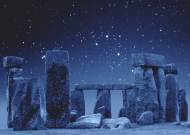 The Sun reaches its lowest position in the sky on December 22nd this year; the date of the winter solstice, by which time the Sun arcs little more than 12 degrees above the South horizon at local noon from our latitude. With the northern hemisphere tilted away from the Sun, useful daylight amounts to just 7½ hrs, the shortest day.
The Sun reaches its lowest position in the sky on December 22nd this year; the date of the winter solstice, by which time the Sun arcs little more than 12 degrees above the South horizon at local noon from our latitude. With the northern hemisphere tilted away from the Sun, useful daylight amounts to just 7½ hrs, the shortest day.
Latest sunrise and earliest sunset do not however occur on the winter solstice date. The Sun rises latest near the end of December (27 or 28th) and sets earliest mid-month (15 or 16th). Astronomically speaking the winter solstice also marks the first day of winter in the northern hemisphere, but within a few weeks daylight will once again start to lengthen in duration. Now that must be cause for celebration! What shall we call it...errr, Easter?
December 2016 Sky Charts
Click each image to see a full-size Sky Chart:
Additional Image Credits:
- Planets and Comets where not otherwise mentioned: NASA
- Sky Charts: Stellarium Software
- Log in to post comments

